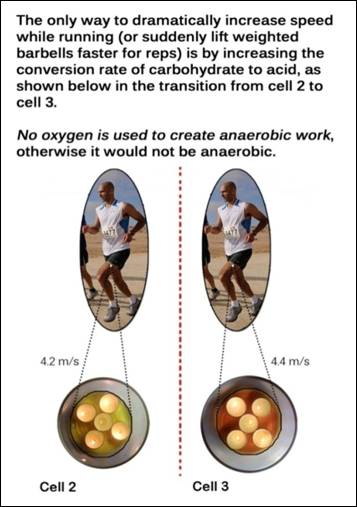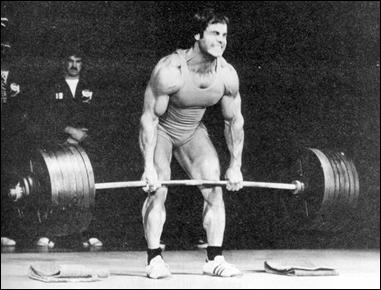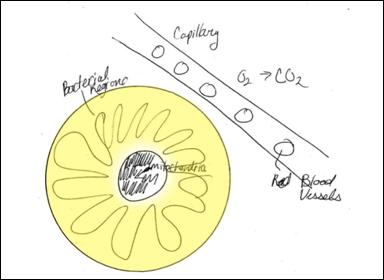Nutrition is an Active Event: Lesson 1
Lesson 1: Muscles, Bacteria, and Acid
Food is used within two different parts of a muscle cell. Each part is depicted in the circular ‘cell model’ image below. One part is represented by lighted votive candles and the other by yellow food colored water outside of the candles.

In a computer created image of a cell model below, varying the shade of yellow coloring outside the candles indicates the rate of carbohydrate a muscle uses during exercise. Imagine the cell models above and below represent a single muscle cell in the thigh muscle of a sprinter.

Darker shades of yellow indicate a muscle uses progressively more carbohydrate as exercise intensity increases. Therefore the muscle cell on the right is using more carbohydrate and working at a higher exercise intensity compared to the muscle cell on the left.
The next section shows below compares real life examples.
Compare world class sprinters running a 100m dash to a girl riding slowly on a bike. Obviously the girl’s legs work at a much lower intensity compared to the sprinters. We should, and indeed do see a lighter shade of yellow (outside the candles) in the girl’s muscle cell. Therefore this color code tells us she is using less carbohydrate to produce power.

Physical movement, including healing and regeneration of your body is powered by cells ‘working’ and consuming food. Cells consume food as they work even when movement is not involved. Before you were born, all your cells ‘worked’ to create you, beginning with the division of two cells. The food your mother ate fed your cells; now you must eat to generate movement and to regenerate your cells and whole body.

Exercise physiology examines how the body uses food while resting, not just during exercise. Cells continue working while ‘we appear to be resting’, so we must consider resting as part of the ‘whole working picture’ just as we consider a car engine at idle or a woman sitting in a tree both consume fuel. The whole picture spans the entire ‘energetic spectrum’ of human movement, from rest to maximum intensity levels.

Similarly to an idling engine, a developing fetus or meditating woman’s cells never stop consuming food and producing waste; acid is just one waste product produced 24/7. Notice in the muscle cell below I wrote “carbs convert to acid in cytosol”. Cytosol is the proper name of the outer section. The cytosol of your muscle cells can use only carbohydrate as fuel. Fat can’t burn in this section of your muscles.

Acid production increases slowly as exercise intensity or speed increases from resting, but then skyrockets exponentially at a certain point. The graph below shows lactic acid increasing as exercise intensity increases.

Similarly to muscles, bacteria living in your intestines convert carbohydrate to acid. Keep in mind, muscle metabolism produces only one type of acid – lactic acid.* Conversely, gut flora produce a variety of other acids, including lactic acid and a small amount of alcohol and nail polish remover (acetone). The image below shows a variety of acids produced within the guts of cows and humans. Comparing cows and humans reveals much about energy intake, weight gain, antibiotics, immunity, and more (examined later).

As muscles and bacteria consume carbohydrate at a higher rate, acid is simultaneously produced at a faster rate. Thus, darker shading in each illustration indicates two things. 1: quantity of carbohydrate converted. 2: quantity of acid produced.

You can sprint without breathing. Absolutely no oxygen is needed to produce high powered movement. More precisely, movement powered without oxygen = anaerobic work. Fermenting carbohydrate at a very high rate is the only way to produce very high power.** This explains why lactic acid production skyrockets during high intensity exercise and why high powered movements are unsustainable. Extreme acid production tends to shut a cell down. Aerobic metabolism (movement powered by using oxygen) cannot produce high powered movements.

Naturally, it’s stupid to sprint without breathing, but the point is you can. Holding your breath does not prevent you from rising out of your chair and sprinting for 20 yards or performing a 6-rep set of deadlifts. I am NOT saying other parts of your body no longer use oxygen during high powered exertions. I am saying the cytosol of the specific muscles producing anaerobic power during sprinting or lifting heavy weight do not use oxygen, by principle. This ‘power principle’ explains why white meat is white compared to dark meat in animals like chickens. The ‘white’ muscles are the fast twitch muscles geared for the most explosive movements, when no oxygen is necessary to move. For example, a chicken uses its white breast muscles very intensely and briefly during ‘fight or flight’. This intense power output requires fermenting carbohydrate.
Dark meat is ‘reddish’ because it contains more myoglobin. Myoglobin is a red, oxygen-binding pigment within slow twitch muscles that gears these muscles for uptaking lots of oxygen and endurance activity. Chicken breasts obviously lack this protein, whereas chicken legs contain plenty. Therefore a chicken’s leg muscles use more oxygen compared to their breast muscles and ‘endure’ working for long periods of time (allowing for hen pecking), but cannot contract as explosively. In short, using oxygen allows muscles to work longer, but not explosively.
Using oxygen to produce movement = aerobic metabolism = oxidative metabolism.
https://physicalrules.com/edslessons.com/msohtmlclip1/01/clip_image021.jpg
Not using oxygen to produce movement = anaerobic metabolism = fermenting carbs into lactic acid.
Using oxygen to produce energy results in slower, less explosive movement compared to fermenting carbohydrates. Moving without utilizing oxygen is the exclusive domain of very high intensity exercise, e.g. weight lifting and running 1500 meter races or shorter distances at competitive speeds. High powered, anaerobic events deplete greater amounts of carbohydrate compared to all slower and less intense movements. This explains why ‘high carb’ diets are inappropriate for people who exercise less or exercise at lower intensities. See graphs in Lesson 25.

Anaerobic ‘work’ applies to ALL cells of the body, not just muscles. It just so happens we ‘see’ muscles work because they are specialized cells which contract or physically shorten as they transform food into movement. Comparatively, other cells – e.g. brain, kidney, ovary cells – do not contract as they ‘perform work’. It is important to know, either anaerobic or aerobic metabolism implies the production of power, energy, or work within all cells, but ‘power and work’ in most cells do not create movement.
Muscle cells are one of a kind; they are a gateway for understanding how all cells work for two reasons:
One: All cells operate similarly. They feed aerobically or anaerobically. Two: Muscles cells are the only cells we can relate to in a concrete sense because we see and feel what they do. We command muscle cells at will. People of all ages relate to physical control and palpably sensed experiences, thus making muscle cells the ideal model for teaching nutrition, biochemistry, and more.
It is most practical to imagine the cytosol of a muscle cell as essentially identical to anaerobic bacteria or just consider it the ‘bacterial section’ as indicated by a student’s hand drawing below. Now consider the fact your intestinal tract is oxygen deprived. This mean anaerobes living within your gut have no choice but to break food down in a way that does not involve oxygen, if they are going to survive. Because feeding anaerobically is ‘their only choice’ they possess machinery designed to ‘eat’ only carbohydrate. Likewise, cytosol of your muscles cells ‘possess machinery’ to feed only anaerobically.

In short, gut bacteria and cytosol are anaerobic digesters. Both convert carbohydrates to acid using the same chemical reaction, namely fermentation. Humans control the fermentation rate in muscles by voluntarily working harder and/or faster. In other words, we make our muscles ‘eat carbohydrates’ either slowly or quickly! The fermentation intensity within the gut is determined by the population density and sheer numbers of bacteria and not by their individual ‘speed of eating’.
Up to this point, we have ignored and will continue to ignore the section of a muscle cell that uses food and oxygen, represented by candles. Deliberately focusing only on the cytosol and acid production forced you to unconsciously disregard other ‘nutritional options’ available to a muscle cell. You were ‘forced’ to see: movement powered without oxygen occurs solely from the conversion of carbohydrates into lactic acid.***
Go to Lesson 2: The Magus of Metabolism: Frances G. Benedict
